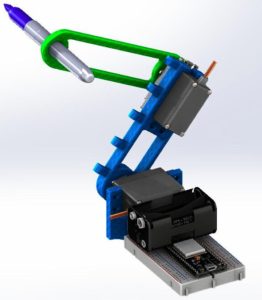An open-source robotic arm for online education has been developed by researchers at Tecnologico de Monterrey in Mexico.
The low-cost arm is designed to enable teachers to remotely demonstrate theoretical concepts during online lessons. It can also be easily assembled by teachers and educators, according to Victor Benitez, one of the researchers.
He said: “This project began during the Covid-19 outbreak back in March 2020. After learning about direct and inverse kinematics and its applications, two students came to me with the idea of creating a two-link robotic arm with IoT capabilities as a project for their robotics class.”
According to the Benitez, the team then set out to create an affordable robot that can showcase complex robotics concepts without the need for advanced tools and equipment.
The system features an electromechanical arm structure, a control system, a wi-fi communications module and a human-machine interface. It is entirely open source and modifiable, enabling educators to access its design and adapt it according to their specific needs.

Benitez explained: “Our robotic arm uses a mathematical process called kinematics. Direct kinematics consists of using matrices with the desired joint angle values to determine the position of the end effector. We used the Denavit-Hartenberg convention to implement this behaviour in the robot.
“On the other hand, indirect kinematics are mainly trigonometric equations that create relations between lengths and angles to calculate how the joints of the arm need to move for the end effector to reach a given point or trajectory in space.”
The trajectory that a robotic arm needs to follow to move an end effector to a specific place is determined by specific coordinates or parametric functions. In this context, the end effector could be any object that the arm is trying to move, such as a marker pen, a laser or even a robotic gripper.
The team said the robot arm has low production costs in contrast with existing robotic arms. It can also be connected to wi-fi sources, enabling it to be controlled remotely via an app. This, according to the team, makes it suitable for remote learning as it allows teachers and students who are communicating over the internet to experiment with the same arm.
Furthermore, the programme is based on permits for users to access every command and parameter behind the arm’s movements. This further supports learning and enhances students’ understanding of underpinning robot behaviour.
A second version that aims to improve the performance and reliability of the original design is currently under development.







